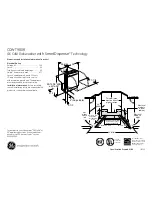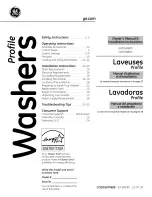
en
24
White stains on the utensils/glasses
remain milky.
If phosphate-free detergents are used with
hard tap water, white deposits may be
deposited more easily on utensils and
the container walls.
–
Too little/unsuitable detergent.
–
Too weak programme selected.
–
No/too little rinse aid.
–
No/too little special salt.
–
Water softening system set to the
wrong value.
–
Salt dispenser lock not fastened.
Contact the detergent manufacturer,
in particular if:
–
the utensils are very wet at the end of
the programme.
–
limescale forms.
Dull, discoloured glasses, film cannot be
washed off.
–
Unsuitable detergent.
–
Glasses not dishwasher-proof.
Streaks on glasses and cutlery, glasses
have metallic appearance.
–
Too much rinse aid.
Plastic parts discoloured.
–
Too little/unsuitable detergent.
–
Too weak programme selected.
Rust spots on the cutlery.
–
Cutlery not rust-resistant.
–
Salt content in the rinsing water too
high, as salt dispenser lock not
fastened firmly or salt was spilled while
being refilled.
Utensils not dry.
–
Appliance door opened too early and
utensils taken out too early.
–
Programme selected without drying.
–
Too little/unsuitable rinse aid.
–
Activate intensive drying.
–
The combined detergent used has
a poor drying performance.
Use rinse aid (see Rinse aid chapter
for setting).
If the advice given does not resolve your
problem, please contact your customer
service. Contact details can be found on
the back cover of this instruction manual
or in the enclosed customer service list.
When calling , please quote the appliance
number (1) and the production date
(FD = 2) which can be found on the rating
plate
92
on the appliance door.
Rely on the expertise of the
manufacturer.
Call us to ensure that the
repair will be carried out by fully-trained
service engineers, who are equipped with
original spare parts for your appliance.
Customer service
)'







































